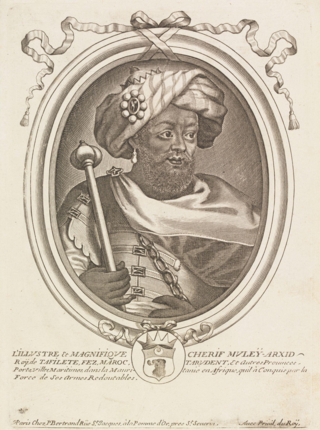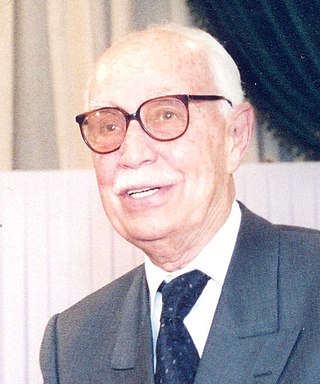| Moroccan literature |
|---|
| Moroccan writers |
| Forms |
| Criticism and awards |
| See also |
This is a list of writers from Morocco.

Moulay Ismail Ibn Sharif, born around 1645 in Sijilmassa and died on 22 March 1727 at Meknes, was a Sultan of Morocco from 1672 to 1727, as the second ruler of the 'Alawi dynasty. He was the seventh son of Moulay Sharif and was governor of the province of Fez and the north of Morocco from 1667 until the death of his half-brother, Sultan Moulay Rashid in 1672. He was proclaimed sultan at Fez, but spent several years in conflict with his nephew Moulay Ahmed ben Mehrez, who also claimed the throne, until the latter's death in 1687. Moulay Ismail's 55-year reign is the longest of any sultan of Morocco. During his lifetime, Isma’il amassed a harem of over 500 women with more than 800 confirmed biological children, making him one of the most prodigious fathers in recorded history.

Moulay Al-Rashid ibn Sharif, known as Moulay Al-Rashid or Moulay Rachid, sometimes called Tafiletta by the English, was Sultan of Morocco from 1666 to 1672. He was the son of the founder of the 'Alawi dynasty, Moulay Sharif, who took power in the Tafilalt region in 1631.
Abul Amlak Moulay Sharif ibn 'Ali was an Arab Emir of Tafilalt from 1631 to 1636. He was a sharif whose family claimed to be descended from the Islamic prophet Muhammad through his grandson Hasan. Moulay Sharif is considered to be the founder of the Alaouite Dynasty of Morocco for being the father of Sidi Muhammad, Al-Rashid of Morocco, and Ismail Ibn Sharif.
Moroccan literature is the literature produced by people who lived in or were culturally connected to Morocco and the historical states that have existed partially or entirely within the geographical area that is now Morocco. Apart from the various forms of oral literature, the written literature of Morocco encompasses various genres, including poetry, prose, theater, and nonfiction like religious literature. Moroccan literature was and is mainly written in Arabic and French, but at a lesser extent also in Berber languages, Judeo-Arabic, Spanish and after the mid-19th century in English. Through translations into English and other languages, Moroccan literature originally written in Arabic or one of the other native languages has become accessible to readers worldwide.
Ahmed Sefrioui was a Moroccan novelist and pioneer of Moroccan literature in the French language.
Sultan Sidi Muhammad ibn Sharif ibn Ali ibn Muhammad was an Arab ruler of Tafilalt, Morocco between 1636 and 1664. He was the eldest son of Moulay Sharif ibn Ali and came to power when his father stepped down. He was killed on 2 August 1664 in a battle on the plain of Angad by troops of his half-brother Moulay Rachid.
Shihab al-Din abu l-‘Abbas Ahmad ibn Mohammed ibn Mohammed ibn Ahmed ibn Ali ibn 'Abd ar-Rahman ibn Abi'l-'Afiyya al-Miknasi az-Zanati, known simply as Ahmad ibn al-Qadi or Ibn al-Qadi (1552/1553–1616), was a Moroccan polygraph. He was the leading writer from Ahmad al-Mansur's court in Morocco next to Abd al-Aziz al-Fishtali. He was also a renowned judge and mathematician.
Abu al-Qasim al-Zayyani or, in full, Abu al-Qasim ibn Ahmad ibn Ali ibn Ibrahim az-Zayyani (1734/35–1833) was a Moroccan historian, geographer, poet and statesman from the Berber Zayane tribe in Morocco. He undertook diplomatic missions to the Ottoman court and engineered government attempts to bring tribes under central authority. His writings include several historical accounts of the Ottoman and Alaouite dynasties. Az-Zayyani wrote fifteen works in the field of history and geography. Some authors even consider him the greatest historian of Morocco.
Sidi Abderrahman el Majdoub, also transcribed as Mejdub, full name al-Shaykh Abu Zayd Abderrahman al-Majdoub ibn Ayyad ibn Yaacub ibn Salama ibn Khashan al-Sanhaji al-Dukkali, was a Moroccan poet, Sufi and mystic. Many lines of his poems are known throughout the Maghreb, and his work is the source of many proverbs.
Abu Zaid Abd al-Rahman Abu Muhammad Ibn Abd al-Qadir al-Fasi was a Moroccan writer in the field of law, history, astronomy and music. He wrote some 170 books and has been called the Suyuti of his time. He was born in the prominent family of al-Fasi and he was a follower of his father, the Sufi saint Abd al-Qadir Ibn Ali Ibn Yusuf al-Fasi (1599–1680).

Abdelkrim Ghallab was a Moroccan political journalist, cultural commentator, and novelist. He is an important figure both in the literary and political field.
Abu Salim 'Abd Allah ibn Mohammed ibn Abu Bakr al-'Ayyashi was a well-known travel writer, poet, lawyer, and Sufi scholar from Morocco.
Lalla Khanatha bint Bakkar (1668–1754), was one of the wives of Sultan Moulay Ismail, and acted as his de facto First Minister and Secretary. After his death, she remained active in the political governance of Morocco during the unstable situation which followed as the mother of Sultan Moulay Abdallah.

Muhammad al-Rudani was a Moroccan polymath who was active as an astronomer, grammarian, jurist, logician, mathematician and poet.
Abu Abd Allah Muhammad ibn Muhammad al-Ifrani al-Susi al-Marrakushi, called al-Saghir, was a Moroccan historian and biographer.

The General Directorate for Studies and Documentation is the foreign intelligence agency of Morocco, under authority of the Administration for National Defense. It is officially tasked with maintaining national security and the safety of national institutions.

The Zawiyaof Sidi Abdelkader al-Fassi, also known as the Zawiya al-Fassiya, is one of the most important historical zawiyas in Fes, Morocco. It is named after Sidi Abdelkader al-Fassi, a highly important 17th-century Muslim scholar, mufti, and Sufi saint of the city who is buried in the zawiya. The building is located in the Qalqliyin neighbourhood in the south of Fes el-Bali, the old medina of Fes. It was one of several zawiya sites in the city and across the country which were associated with the al-Fassiya tradition of Sufism.
Muhammad ibn al-Qasim al-Badisi was a Moroccan astronomer, poet and writer.
Oum el-Iman bint Ali el-Bethary also known as Oum el-Youmn bint Mahalli was the wife of the Moroccan Emir of the Marinid Sultanate Abd al-Haqq I and the mother of Abu Yusuf Yaqub ibn Abd al-Haqq. She was from the Zenata group of tribes and is considered a walia (saint) in Morocco.